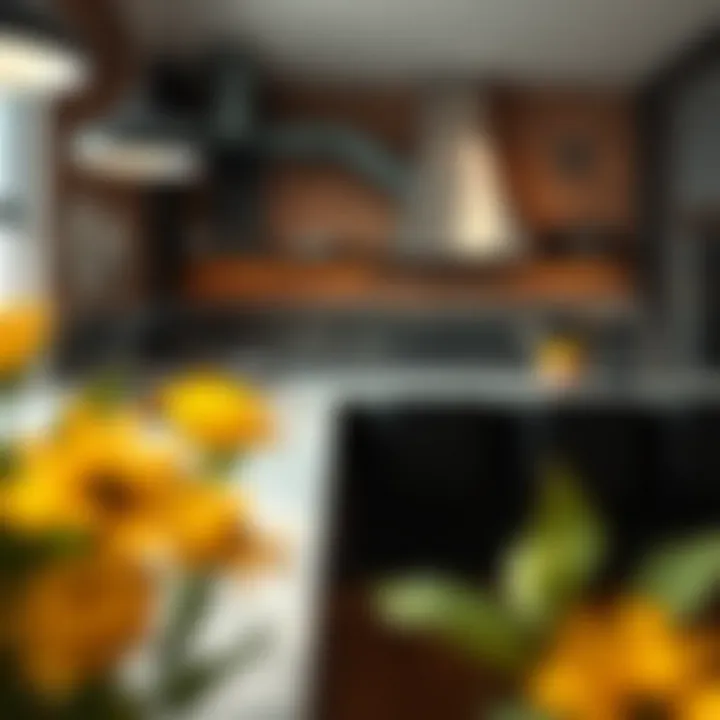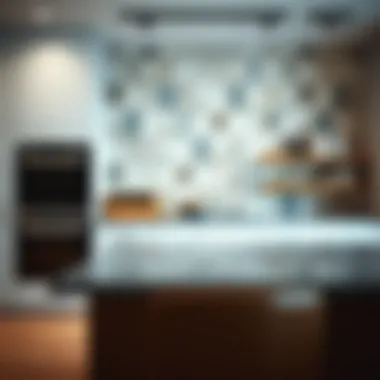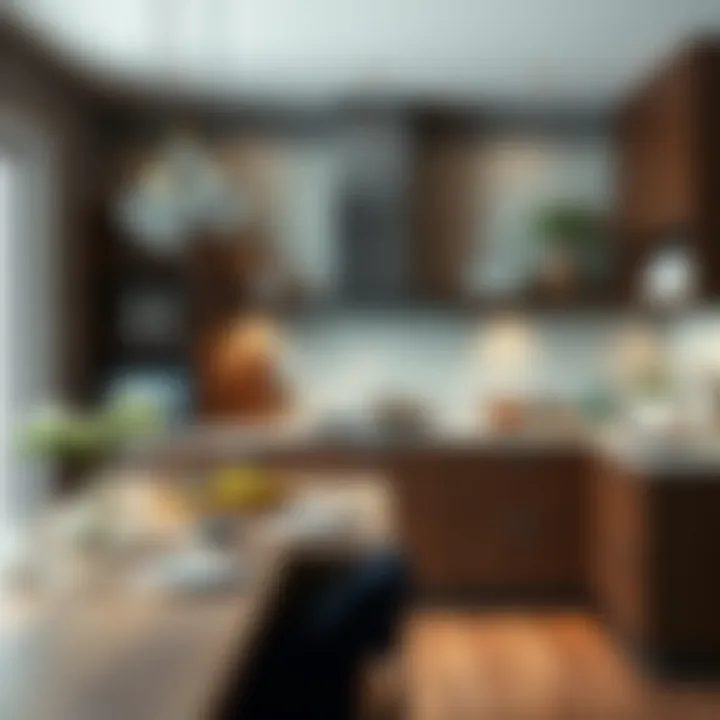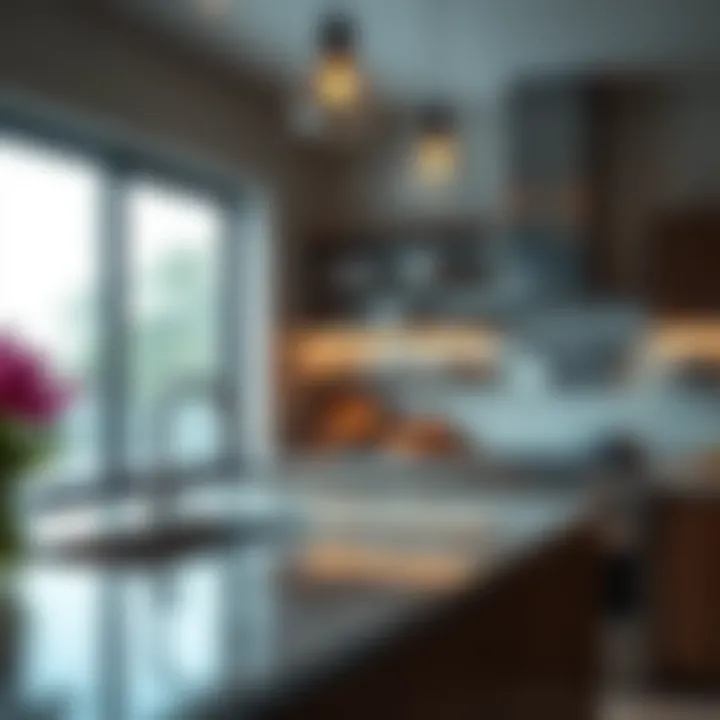Enhancing Kitchen Design with Tile Panels


Intro
In today's world of kitchen design, tile panels have emerged as a popular choice for homeowners and interior decorators alike. Their versatility and visual appeal make them an attractive option for enhancing the overall allure of a kitchen space. This article aims to unpack the tremendous potential that tile panels hold, diving into their aesthetic appeal, practicality, installation techniques, and contemporary trends. Each section will address critical factors that influence their integration into kitchen designs, providing readers with a well-rounded understanding of how these materials can enhance both beauty and functionality in modern kitchens.
The charm of tile panels goes beyond mere visuals; they provide durability and ease of maintenance that aligns perfectly with the hectic lifestyles many lead today. Whether it's an inviting backsplash that draws the eye or sizeable wall tiles offering a sleek finish, these panels can create stunning focal points. Moreover, advancements in design and technology have opened the doors to an array of colors, textures, and styles, ensuring there’s something to fit every unique taste and kitchen layout.
In the following sections, we will explore various dimensions of tile panels, paving the way for informed decisions that can significantly elevate kitchen design. Let's get started on this journey through the world of tile panels.
Intro to Tile Panels in Kitchen Design
In the realm of kitchen design, tile panels have carved out a niche that is both functional and aesthetic. With a surge in the desire for personalized, stylish spaces, understanding the significance of tile panels becomes pivotal for homeowners and designers alike. Not only do these panels transform the visual appeal of kitchens, but they also provide real-world benefits like durability and ease of cleaning.
The Role of Tile Panels
Tile panels serve multiple roles in kitchen design, bridging the gaps between functionality and artistic expression. Beyond just looking good, they protect walls from moisture and stains, which is vital in a space often bustling with culinary activity. Their easy-to-clean surfaces become a practical choice for busy households. Additionally, tile panels expand the possibilities for design, allowing for a myriad of colors, patterns, and textures that can completely change the character of a kitchen. For instance, a glossy black tile panel can project sleek modernity, while distressed, hand-painted tiles bring a rustic charm.
Historical Context
The use of tile in kitchens isn't a new trend; it’s rooted in centuries of design evolution. Historically, different cultures embraced tiles for their beauty and practical benefits. In ancient Rome, for example, mosaic tiles adorned not just kitchens but entire public spaces, reflecting both artistry and mastery in craftsmanship. Over the decades, the styles have shifted from the intricate patterns of Victorian design to the minimalistic aesthetics favored in contemporary homes. This evolution showcases how tile panels have adapted with changing tastes and technologies, from handcrafted artisan pieces to standardized production methods. Today, the possibilities are continually expanding, making tile panels a timeless choice that resonates across generations.
"Tiles are not just as building materials; they are storytellers that define spaces and memories."
In essence, exploring tile panels in kitchen design touches upon essential themes that weave together aesthetic sensibility, historical relevance, and practical functionality. By embracing tile panels, designers and homeowners alike can curate spaces that reflect personal style while meeting everyday needs.
Types of Tile Panels
When it comes to kitchen design, choosing the appropriate tile panel can be a make-or-break decision. The variety of tile panels available caters to a wide range of aesthetic preferences and functional needs. Understanding the different types helps homeowners, designers, and DIYers make informed choices that enhance both visual appeal and usability in kitchen spaces. Each tile type comes with its unique characteristics, benefits, and considerations, shaping not only the overall look of the kitchen but also its maintenance needs, durability, and installation processes.
Ceramic Tile Panels
Ceramic tile panels have long been a staple in kitchen design. Made from clay fired at high temperatures, these tiles are known for their affordability and versatility. Available in a myriad of colors, sizes, and finishes, ceramic tiles can easily fit into any design scheme, whether it is rustic or contemporary.
- Benefits of Ceramic Tiles:
- Durability: They resist scratches and stains, ideal for the busy kitchen environment.
- Cost-effective: Generally more affordable than other tile types, making them a great option for budget-conscious renovations.
- Variety: The expansive selection offers countless design possibilities.
Despite their advantages, ceramic tiles may require regular sealing to prevent stains from penetrating, which can be a consideration for some homeowners.
Porcelain Tile Panels
Known for their incredible hardness and low porosity, porcelain tile panels are a premium upgrade to consider. These tiles are denser and more durable than regular ceramic tiles, making them resistant to water and more suitable for high-traffic areas.
- Key Characteristics:
- Weather Resistant: Suitable for indoor and outdoor use, they can withstand harsh conditions.
- Easy Maintenance: Less prone to staining, they only need regular cleaning with mild detergent.
- Design Flexibility: Available in numerous finishes, they can mimic natural stone or wood effortlessly.
Homeowners may find that the upfront cost is higher, but the longevity and low maintenance can justify the investment over time.
Glass Tile Panels
For those looking to make a statement, glass tile panels elevate a kitchen's aesthetic. They catch and reflect light, adding an element of depth and visual intrigue. Often used as backsplashes or accents, glass tiles can create stunning focal points.
- Advantages:
- Light Reflection: The glossy finish enhances brightness in the kitchen, making smaller spaces feel larger.
- Water Resistant: Ideal for areas exposed to moisture.
- Eco-Friendly Options: Many glass tiles are made from recycled materials, appealing to the environmentally conscious.
However, they may chip more easily and generally require special adhesives for installation, which can add to the overall project costs. Proper care should also be taken when cleaning, as abrasive cleaners can scratch the surface.
Natural Stone Tile Panels
Natural stone tiles, such as marble, granite, and slate, bring an air of luxury to any kitchen. Each piece has its unique character due to natural variations in the stone. This uniqueness creates an upscale look that many homeowners desire.
- Benefits:
- Durability: Stone tiles are resilient and can last a lifetime if properly maintained.
- Natural Aesthetic: Their beauty lies in their organic patterns and textures.
- Heat Resistance: Perfect for areas near stoves or ovens, as they can withstand high temperatures.
Nevertheless, these tiles often require sealing to prevent stains and can be pricier, both in material costs and installation. Homeowners should balance the cost with the long-term benefits that natural stone provides.


In summary, understanding the various tile options is crucial for anyone pursuing a kitchen remodel. Each type of tile panel—ceramic, porcelain, glass, and natural stone—offers unique advantages and considerations that can complement both style and functionality. Making a choice based on aesthetic preference, maintenance needs, and budget will lead to a kitchen that remains not only beautiful but practical for years to come.
Benefits of Using Tile Panels
In the realm of kitchen design, tile panels are more than mere decorative elements; they play a crucial role in melding aesthetics with functionality. The kitchen often serves as the heart of the home, where families gather, meals are prepared, and memories are created. Therefore, selecting materials that enhance both style and practicality is essential. Tile panels offer unique advantages that resonate with both homeowners and designers alike. By understanding the benefits of tile panels, one can make informed choices that elevate the kitchen experience.
Durability and Longevity
When it comes to durability, tile panels stand the test of time. Made from robust materials like ceramic and porcelain, they resist scratches, stains, and moisture, making them ideally suited for the kitchen environment. Unlike laminate or paint, tile panels do not easily chip and are seldom affected by heat or spills. This resilience translates into a longer lifespan, meaning one doesn’t have to worry about regular replacements or extensive maintenance over the years.
For instance, consider the importance of tile panels behind a stovetop area. They can withstand the heat and splatter from cooking, serving not just as a protective layer, but as a lasting element that does not compromise on appearance. Homeowners looking for a practical yet stylish solution will find tile panels to be a wise investment for enduring kitchen design.
Ease of Maintenance
In a busy household, easy maintenance is a must. Tile panels, given their smooth surface and sturdy composition, require less effort to keep clean compared to many other kitchen wall options. A simple wipe down with a damp cloth often suffices. For tougher stains, a gentle cleaner is usually all that’s needed. In contrast, materials that absorb stains, like certain woods or porous finishes, can require considerable effort and specialized care to maintain their appearance.
It's also worth noting that some tiles have coatings that enhance stain resistance, further simplifying the upkeep process. Homeowners can enjoy a clean, fresh look in their kitchens without the stress of persistent cleaning rituals. With busy schedules in mind, tile panels provide a practical answer to modern living.
Aesthetic Versatility
One of the standout features of tile panels is their aesthetic versatility. Tile panels come in a myriad of colors, sizes, patterns, and finishes, enabling homeowners to choose options that reflect their personal style. Want a sleek, minimalistic design? Opt for large-format porcelain panels in neutral tones. Prefer bold and vibrant options? Mosaic glass tiles in an array of colors can add a striking visual element.
This adaptability allows for seamless integration into various kitchen styles, be it contemporary, rustic, or traditional. The ability to play with textures—smooth glossy finishes versus rugged stone-like surfaces—enables designers to experiment and create unique visual narratives. By mixing and matching different tiles, one can create custom looks that speak to their individuality.
"Tile panels are not just functional; they are a canvas for creativity in kitchen design."
Such versatility is appealing for designers and homeowners aiming to create kitchens that are both functional and visually engaging. In the bustling world of kitchen design, tile panels are a dynamic choice that marries practicality with aesthetic flair.
Choosing the Right Tile Panels for Your Kitchen
Choosing the right tile panels for your kitchen is vital, as it sets the tone for the entire space. The decision blends aesthetics with functionality; one must weigh both style and practical elements. Kitchen areas see quite a bit of wear and tear, therefore, it’s imperative that the materials chosen not only enhance beauty but also operate effectively in a bustling environment. Think of tile panels as the jewelry of your kitchen. Their right selection can adorn and elevate any cooking or dining space, enhancing the way you interact with the area.
Considering Style and Color
When considering style and color for tile panels, one’s personal taste plays a significant role. For instance, a modern minimalist kitchen might benefit from sleek, monochromatic tiles that offer clean lines, while a rustic farmhouse design could utilize earthy tones and textures that evoke warmth and familiarity. It’s not just about what looks good but also how the colors and styles harmonize with existing elements like countertops, cabinets, and appliances.
Here are some factors to keep in mind:
- Incorporation of Current Trends: Paying attention to current trends can afford you insight into color palettes and styles that are en vogue. For example, deep blues and greens are gaining traction in modern kitchens, paired with brass or gold hardware for contrast.
- Creating Cohesion: Make sure your chosen color scheme links well with existing components. If you have oak cabinets, lighter ceramic tiles can create a pleasing contrast.
- Setting the Mood: Different colors evoke various feelings; warm hues might foster a cozy atmosphere, while cooler shades can invoke calmness.
Evaluating Tile Size and Shape
Evaluating tile size and shape is another essential aspect when selecting tile panels. The dimensions can radically change how a kitchen feels. Larger tiles often create an illusion of more space, while smaller tiles offer an intricate and intricate aspect. One might consider the following:
- Proportions of the Kitchen: A smaller workspace can feel cramped with large tiles. On the flip side, a grand cooking area can often bear the weight of larger formats without feeling overwhelmed.
- Design Compatibility: Mixing different sizes can create a visually exciting layout. Subway tiles are popular for backsplashes, but when mixed with larger tiles, they can create stunning focal points.
- Maintenance Considerations: Larger tiles usually mean fewer grout lines, translating to easier maintenance, an aspect worth pondering for a busy homeowner.
Assessing Texture and Finish
Lastly, the assessment of texture and finish cannot be overlooked when choosing tile panels for the kitchen. The finish can determine not only the aesthetic aspect of a tile but also its practicality. While glossy finishes might be appealing, they require more frequent cleaning. Textured tiles, meanwhile, might provide a rustic charm but can trap dirt. Consider these points:
- Surface Characteristics: The choice between a glossy, matte, or textured finish can shape the character of the kitchen. Glossy tiles reflect light and can brighten a room, while matte finishes offer a more subdued appearance.
- Functional Considerations: Think about the kitchen's workflow. Non-slip surfaces are imperative for safety, particularly around eating areas or where moisture can be prevalent.
- Visual Interest: Play with different textures to create dimension and intrigue. Using various finishes can break the monotony and add depth to your design.
Remember, selecting the right tile panels is a balance of artistry and function. Observing your kitchen's layout, existing colors, and personal preference will guide your choices and investments.
Choosing the right tile panels translates into more than just aesthetic gain; it creates an environment that can enhance cooking enjoyment and hospitality. Taking the time to think through these decisions will greatly benefit how you enjoy your kitchen moving forward.
Installation of Tile Panels
The installation of tile panels represents a crucial junction in the journey of kitchen design. It's not merely about slapping some tiles on the wall; it's a blend of aesthetics, durability, and functionality that determines how well your kitchen design comes together. Getting the installation right means your beautiful tile panels will not only look great but also stand the test of time, contributing to the overall value of your home.
DIY Installation vs. Professional Help
When it comes to installing tile panels, homeowners often find themselves at a crossroads: Should they take the plunge and handle the job themselves, or is it better to hand over the reins to a professional? Here are some points to consider, and knowledge is power here.
- Cost: DIY can save dough, but the price of mistakes can outweigh the savings.
- Skills: Do you have the knack for precision? Tiling isn’t just a lay-and-go affair. It requires measuring, cutting, and fitting. One wrong cut can throw the whole design out of whack.
- Time: If you’re juggling a busy family life alongside the installation, consider the time investment. A pro can often complete the job quicker, bringing their experience to bear.


Deciding between DIY or hiring a pro will hinge on your comfort level with tools and design, as well as your envisioned budget.
Preparation of the Surface
Before any tile goes up, surface preparation must sit center stage in your to-do list. It’s the bedrock of a lasting installation. A few points to think about:
- Cleaning: Ensure the surface is clean, clear of debris, and dry. Any grime or dust might lead to adhesion problems down the road.
- Leveling: A flat, level surface is non-negotiable. If your walls or counters are uneven, preemptive smoothing through plaster or leveling compounds can save a lot of hassle and heartache.
- Moisture Barrier: For areas prone to dampness, like behind the sink, a moisture barrier is imperative to avoid mold and deterioration.
By laying the groundwork, you're setting yourself up for a smooth installation process.
Adhesive Choices and Application
Choosing the right adhesive is like matching a fine wine with a gourmet meal—get it right, and the marriage enhances both. Installation adhesives vary in types, which can influence how your tile panels bond with the substrate.
- Thin-set mortar: This is a common go-to for many tile types. Its versatility makes it a strong candidate for both floor and wall installations.
- Modified thin-set: If you're installing glass or stone tiles, modified thin-set is often recommended for its stronger hold and flexibility.
- Epoxy: For extra durability and resistance to moisture, epoxy adhesives can be used. They are, however, a bit trickier to work with and may require professional assistance.
Application tips:
- Use a notched trowel to ensure an even layer of adhesive.
- Press tiles firmly into place to eliminate air pockets, which can compromise adhesion.
Grouting Techniques
Grouting is the cherry on top of your tile installation sundae. It not only enhances the beauty but also provides critical support. Key techniques to keep in mind include:
- Choosing the right grout: Whether it’s sanded or unsanded, ensure it’s suitable for your tile size and the spacing between them. Sanded grout is better for wider joints, while unsanded works well for narrow spaces.
- Mixing: Follow the manufacturer's instructions carefully. Incorrect mixing can lead to issues down the line.
- Application: Use a rubber float to apply grout, pushing it into the joints until they’re fully packed.
- Cleaning: Clean excess grout off the tile surface quickly, as it’s much easier to remove when still wet. A damp sponge can help refine the joint lines and remove haze.
Grouting may seem straightforward, yet it’s important for both appearance and longevity. With the right approach, you can achieve flawless results that will stand out.
"A well-installed tile panel is the difference between a mere kitchen and a culinary haven."
Undoubtedly, the installation process sets the tone for the kitchen design. Knowledge and skill in installation help to create a kitchen space that is not only functional but also aesthetically pleasing and designed to last.
Maintenance of Tile Panels
Taking care of tile panels is a crucial aspect often overshadowed by selection and installation. Neglecting maintenance not only shortens the lifespan of these panels but can also detract from the overall aesthetic appeal of your kitchen. Regular maintenance ensures that tile surfaces retain their beauty while enhancing the overall functionality of the space. It is not merely about keeping things tidy; it’s about protecting your investment, ensuring longevity, and sustaining the attractive environment of your kitchen.
Cleaning Methods
When it comes to cleaning tile panels, simplicity meets effectiveness. The right cleaning methods can make a world of difference, especially given that kitchens are prone to grease, spills, and everyday mess. Using appropriate cleaning techniques can preserve the tiles' integrity and appearance without causing damage. Here are some reliable methods:
- Soft Cloths and Sponges: Use a soft cloth or sponge with warm, soapy water for day-to-day cleaning. Avoid abrasive scrubbers as they can scratch the surface, especially on glossy tiles.
- Vinegar and Water Solution: For discolored or stained tiles, mix equal parts of vinegar and warm water. This solution is effective yet gentle, helping to lift stubborn stains.
- Baking Soda Paste: For tougher stains on grout lines, a paste of baking soda and water can work wonders. Apply it, let it sit for a few minutes, and then scrub gently with a toothbrush.
"Regular cleaning not only extends the life of your tiles but also keeps your kitchen looking fresh and inviting."
Preventing Damage
Preventing damage is key to maintaining the pristine condition of tile panels. An ounce of prevention is worth a pound of cure, as the saying goes. Here are vital considerations to keep in mind:
- Avoid Heavy Impacts: Tile panels, particularly glass and porcelain varieties, can chip or crack under heavy impacts. Being cautious with kitchen tools and appliances can go a long way in preserving your tile's surface.
- Seal Grout Lines: Grout lines are often the weakest link in tile installations. Sealing the grout can prevent moisture absorption, reducing the likelihood of mold and stains.
- Use Protective Mats: Placing mats in high-traffic areas, especially near the sink or cooking range, can minimize wear and tear.
- Monitor For Cracks: Regularly inspect your tiles for any signs of cracks or damage. Addressing small issues early can prevent more significant repairs down the road.
By following these cleaning and preventive techniques, homeowners can significantly extend the lifespan of their tile panels, ensuring the kitchen remains a desirable space for years to come.
Current Trends in Tile Panel Design
In the ever-evolving realm of interior design, tile panels have become a favorite among homeowners and designers alike. This shift is driven by the continuous search for both aesthetic charm and functional performance in kitchens. Currently, several trends are redefining how tile panels are integrated into modern kitchen spaces. Understanding these trends is essential, as they not only influence design choices but also reflect broader shifts in environmental consciousness and personal style.
Sustainable Materials
Sustainability is not just a buzzword; it's a movement making waves in the tile industry. There’s a growing preference for tile panels crafted from recycled or eco-friendly materials. This trend resonates with many consumers who wish to adopt a more responsible approach to design while also contributing to reducing environmental footprints. For instance, some manufacturers offer tile made from reclaimed materials such as glass or ceramic, which not only cuts down waste but also brings a unique aesthetic quality to the kitchen.
Benefits of Using Sustainable Materials:
- Reduced Environmental Impact: Using less energy in production processes.
- Unique Aesthetics: Each reclaimed tile carries its story, adding character.
- Long-lasting Performance: Many eco-friendly materials boast durability equivalent to traditional options.
"Embracing sustainable materials in kitchen design isn't merely about aesthetics; it’s about crafting a better future for our planet."


Textured Surfaces
Another trend catching the eye of design enthusiasts is textured surfaces. Gone are the days when flat, glossy tiles ruled the roost. Today, homeowners are gravitating toward tiles with varied textures, whether it's a rustic stone finish or a tactile, ribbed ceramic. These surfaces add depth to any design and invite interaction.
- Visual Interest: Textured tiles draw the eye, breaking the monotony often associated with smooth surfaces.
- Tactile Engagement: The added touch of texture encourages a sensory experience while cooking or entertaining.
- Versatile Applications: Textured panels work great as a backsplash or accent walls, enhancing areas often overlooked.
Incorporating texture into a kitchen can provide not just a visual feast but also create an inviting atmosphere.
Bold Patterns and Colors
The kitchen is increasingly seen as the heart of the home, and bold patterns and colors are taking center stage in this vital space. Whether it’s geometric designs, vibrant colors, or intricate mosaics, homeowners are willing to push the design envelope. This trend allows for personal expression and adds a whimsical touch.
Why Bold Patterns and Colors Matter:
- Personal Expression: Kitchens can reflect personal style, showcasing individuality.
- Mood Enhancement: Bright colors and dynamic patterns can uplift the space, making it more enjoyable to spend time in.
- Focal Points: A striking tile panel can serve as an eye-catching centerpiece in an otherwise neutral space.
Homeowners aiming for a cozy yet dynamic vibe might consider hexagonal tiles in various hues or a colorful mosaic that catches the light.
Adopting these trends in tile panel design not only enhances the aesthetics of a kitchen but also speaks volumes about the values of the homeowner. From sustainability and texture to expressive patterns, each element works synergistically to create a kitchen that is not only functional but also a true reflection of personal style.
Integrating Tile Panels with Kitchen Fixtures
When diving into the world of kitchen design, the integration of tile panels with fixtures becomes a fundamental element that cannot be overlooked. This process is not merely about slapping some tiles onto a wall; it’s about creating a harmonious space where every component, from the countertops to the cabinets, plays a part in a cohesive whole. The attention paid to this integration can transform the kitchen into a functional and aesthetically pleasing haven.
Compatibility with Countertops
The relationship between tile panels and countertops is akin to the bond between a fine wine and gourmet cheese. Choosing the right tile design can elevate the countertops, enhancing the overall look. Often, homeowners will overlook how the color and pattern of tile panels can either clash or beautifully complement the surfaces beneath.
When opting for tile panels, consider the following:
- Color Coordination: Ensure the hues of the tile mesh well with the countertops. If your countertops are a solid, dark color like granite, bright or textural tiles can add delightful contrast. Alternatively, lighter countertops can benefit from patterned tiles that add depth without overwhelming the space.
- Texture Considerations: Besides color, the texture plays a significant role. A glossy tile panel paired with a matte countertop offers a nice balance, enticing the eye while keeping practicality in check.
- Seamless Transition: The edges between tile panels and countertops should be crafted with precision. Using similar colors or complementary borders can create a seamless feel, making the area look more polished and intentional.
Incorporating these elements into the design is not just about appearance, but also about functionality. Tiles can protect walls from splashes and stains, especially behind sinks and cooking areas, while being easy to clean.
Coordination with Cabinets
Cabinets can often be the unsung heroes of kitchen design, but their pairing with tile panels is crucial for achieving visual balance. This coordination goes beyond the mere physical proximity of the two elements; it's about designing a narrative across your kitchen.
Think about these factors when blending cabinets with tile panels:
- Style Matching: The style of your cabinets should inform the choice of tile. For instance, shabby chic cabinets work beautifully with textured tiles, while sleek, modern cabinets might pair well with glossy, linear tiles.
- Color Synchronization: Craft a coordinated look by ensuring that cabinet colors harmonize with the tile panels. A light wood cabinet against earth-toned tiles can create warmth, while dark cabinets with bright tiles can create a bold statement.
- Functional Flow: The arrangement of cabinets and tile panels should also cater to the workflow within the kitchen. Functional areas like the cooking zone benefit from tiles that are easily accessible and visually appealing, ensuring the space is as workable as it is stylish.
"A well-coordinated kitchen is not just about style; it's about creating a space where function meets beauty seamlessly."
Ultimately, achieving the right integration of tile panels with kitchen fixtures is an art. It is a dance of color, texture, and pattern that, when done well, elevates the overall design of the kitchen. By considering compatibility with both countertops and cabinets, homeowners can craft a kitchen that resonates with their personal style while also being remarkably practical.
Closure
As we draw this exploration into tile panels to a close, it's crucial to reflect on their significant contribution to kitchen design. Tile panels not only serve as protective surfaces that endure the daily wear and tear but also bring a unique aesthetic charm to cooking spaces that cannot be disregarded. Homeowners and designers alike often gravitate towards tile panels for their ability to elevate a room's look without a full remodel, offering a cost-effective solution with solid visual impact.
The Impact of Tile Panels on Kitchen Aesthetics
The aesthetic appeal of tile panels goes beyond mere color and pattern. They can act as statement pieces that draw the eye, creating focal points within kitchens. Whether you opt for a glossy glass tile that reflects light or a rustic stone that tells a story, tile panels transform dull walls into works of art. This versatility allows one to maintain an overall theme while incorporating various elements that express personal style.
For instance, pairing a modern ceramic tile with vintage décor can create a compelling contrast that enhances the kitchen’s personality.
- Heightened Contrast: Dark glossy tiles can be striking against lighter cabinets or countertops, amplifying the overall contrast and elegance.
- Textural Relationships: Mixing different textures, such as smooth glass with coarse stone, adds depth and interest.
- Color Play: Bright tiles interspersed within a neutral palette can bring life and excitement to the space, acting as colorful accents.
In such, tile panels breathe life into kitchens, allowing creative expression within a functional environment. As trends evolve, so too does the range of available designs, sourcing from various cultures and historical contexts, ensuring there’s always something fresh to consider.
Future Prospects in Tile Panel Design
Looking ahead, the realm of tile panels is ripe for innovation. As sustainability takes precedence in design, manufacturers increasingly adopt eco-friendly materials and practices. Recycled glass tiles or sustainably-sourced natural stones will likely become staples, aligning design with environmental responsibility.
Furthermore, advancements in technology—like digitized printing on tiles—are paving the way for more intricate and personalized designs to emerge. Imagine custom panels that reflect a homeowner's personal photos or memories, right on the kitchen wall. As connectivity in homes advances, so will smart tiles that have integrated features such as wireless charging capabilities or mood lighting.
- Sustainable Options: Expect increased availability of tiles made from recycled materials, appealing to environmentally conscious consumers.
- Technology Integration: There might arise tiles with LEDs or sensors that can enhance the kitchen experience.
- Customization Trends: The demand for custom designs will push the envelope in terms of what homeowners can envision and create.
Tile panels will continue to evolve, reflecting and incorporating the latest global trends. Homeowners and designers can look forward to a future filled with possibilities that not only satisfy practical needs but also aesthetic aspirations.
Embracing these elements ensures kitchens remain vibrant, functional, and stylish well into the future.







